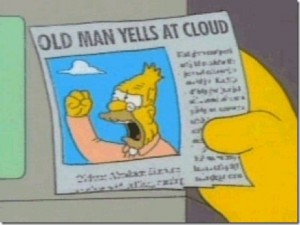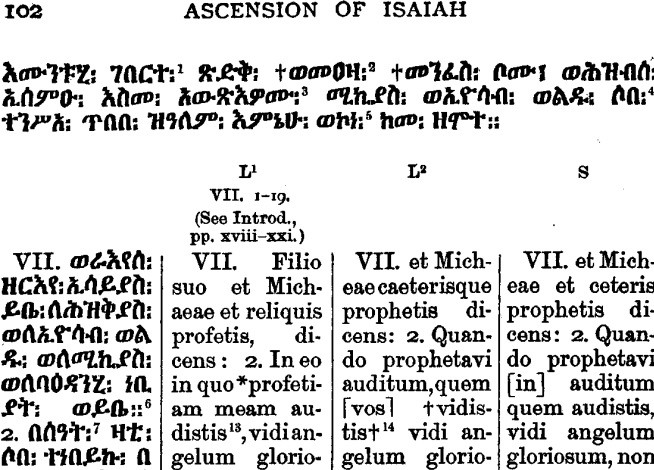
We’re back!
Did you miss us?
Our recent downtime was self-inflicted. (I know Watts you’re thinking.) But anyhow, we’re on a new server in the Netherlands now, and so far everything seems to be working fine.
Musings on biblical studies, politics, religion, ethics, human nature, tidbits from science



[Observant readers will recall that we tackled this subject once before in When Is Paul’s Silence Golden?]
The standard historicist response to the question of Paul’s silence on the historical Jesus relies heavily on Freudian Kettle Logic — to wit, “(1) Paul did mention Jesus quite a bit; (2) We shouldn’t be surprised that Paul didn’t mention Jesus very much at all, for the following ad hoc reasons; (3) You’re an idiot for bringing it up.”
The different ad hoc reasons given for Paul’s silence vary over time. And it’s hard to justify spending too much time refuting them, because they’re functionally equivalent to yelling “Squirrel!” in the middle of a sentence. Perhaps it’s because of the honor/shame society Paul and Jesus lived in. Maybe Paul was an egomaniac. Maybe . . . Squirrel!
Say what you will, but at least there’s plenty of variety. If you don’t feel like hopping on the current ad hoc bus, stay put; another one is coming in 15 minutes. Quote miners in the Apologia Mountains are working ’round the clock to serve you. Pardon the mixed metaphors.
While reading Maurice Casey’s new book, Jesus: Evidence and Argument or Mythicist Myths?, I was dismayed (but not surprised) to find that he’s still using that tired old Context Canard to explain Paul’s silence on the historical Jesus. His preferred ad hoc rescue for Paul’s silence has to do with cultural context, as described in Edward Hall’s Beyond Culture. Apologists argue that the people of the Ancient Near East (including, apparently, Asia Minor and the entire Mediterranean basin) lived in a high context culture.
What does that mean? On the high end of the Hall scale people use implicit language to express themselves. Body language, gestures, facial expressions, shared cultural memory and subtexts, along with other nonverbal modes of communication provide the full range of expression that outsiders will often miss. On the low end, people use explicit language to express themselves. They will often repeat themselves, just to be clear. They do not rely as much, if at all, on nonverbal cues or cultural subtext.
Casey argues:


This continues from my previous post on A.J. Woodman’s argument.
History ain’t what it used to be. It is all too easy for us moderns to read a work by an ancient historian, say Josephus or Tacitus or Thucydides (some would even add a few biblical authors), and think that by making allowances for pre-modern naïvety and a few mythical tales that we are reading a regular account of the past not so very different from what we would expect from our own modern historical works.
Historical works are nothing like epic poetry. At least to us. Historians are trying to get the facts right and record what they believe really happened. Ancient historians, however, did not quite work like that. We have seen in the previous two posts that even that reputably most “modern” and “scientific” of ancient historians, Thucydides, looked upon Homer as a historian-predecessor of his. If the Iliad is what Thucydides understood as “history” then perhaps we should be a little more cautious in the way we approach his own historical work, and indeed historical works of all the ancients.
Thucydides rejected poetic presentation. Plain prose was his tool. We saw in the previous post that his rejection of the poetic with all the embellishments that poetry brings with it was not because he believed such a medium was inappropriate for a “historical work”. Rather, it was because he wanted to convince his audience that the subject matter about which he was writing was itself of such grand and superior importance that poetry was superfluous.
The topic or theme was impressive enough on its own merits. In this, the greatness of his subject, his work surpassed that of his predecessors, including Herodotus and Homer.
Thucydides made poetics sound like a cheap way to enhance the greatness of one’s chosen topic.
Below we have a closer look at that prose style and will see that even ancient readers saw something rather poetic about it anyway. Thucydides’ prose was far from pedestrian.
(Pause: Did similar thoughts run through the mind of the author of Luke-Acts? What greater subject to write about than the coming of Christ and the origins of the Church? How to surpass the predecessors?)
In the previous post we saw that Thucydides expressed regret that readers “may seem” to find his work “less entertaining” because it would lack the tales of the fabulous and legendary that were found in The Histories of Herodotus. Woodman’s translation draws attention to what he believes are key details in the Greek that tend to be overlooked by many readers, including scholars. Thucydides, he argues, is not saying that his work will not be found entertaining. He is saying that it will lack the entertainment that comes from the mythical and fabulous narratives since those sorts of stories won’t be a part of his work.
We must infer that he did expect his work to be entertaining in all other respects, which is certainly the impression we derive from 23.1-3, where he returns to the thesis . . . that [his subject matter] the present war is the greatest of all. (p. 28)
Here is 23:1-3
Continue reading “The Best of Ancient Historians Following Homer and the Epic Poets”


Dr Patrik Lindenfors, an associate professor at the Stockholm University, has asked me if I would be willing to help him by advertising his crowdfunded research project on this blog. I am honoured to do so and have just sent a donation to help out as well. He’s asking for public assistance because it’s outside his normal area of research.
His university website lists his areas of research and publications. He also has a personal webpage.
His Facebook page contains summaries of the new project.
The following is extracted from his webpage dedicated to explaining the project and the campaign for public assistance.
I propose to review potential placebo effects of religion and how these may explain why religious beliefs and practices are so common across human populations.

In my regular work I am a researcher of cultural evolution at Stockholm University. I have previously authored the books God Probably Doesn’t Exist, which has been translated into seven languages, and “Samarbete“, a popular science book in Swedish about the biological and cultural evolution of cooperation, currently being translated into English.
Now, I want to explore a proposal that has circulated in books and on-line discussions for a while – if there are any placebo effects of religion and whether these may be a partial explanation of the spread of religious beliefs and practices across human societies. . . . . .
You can read more and find out how to assist on the above links, in particular at the Divine Placebo webpage. Don’t delay though. He’s running out of time.
More from the site: Continue reading “Divine Placebo: A Request to Readers”


This continues from my previous post on A.J. Woodman’s argument.
There are good reasons for approaching the Book of Acts and other historical writings of the Bible from the perspective of the wider literary culture of their day. Thucydides, the Greek historian of the Peloponnesian War, is generally thought of as an outstanding exception among ancient historians because of his supposedly well-researched and eyewitness accounts of the facts. Classicist Professor A.J.Woodman reminds us, however, that we may be advised to reconsider why we should ever think of anyone as being an exception to the ethos and culture of one’s own day.
Through these posts I am exploring the nature of ancient historiography, and by implication re-examining the assumptions we bring to our reading of the Bible’s historical books. Beginning with Herodotus and Thucydides is relevant because we will see that Jewish historians, in particular Josephus, were influenced by them. We will see that by understanding Greek and Roman historians we will also understand more clearly and in a new light the nature of the works of Josephus. And by understanding the nature of ancient historical texts we will read Acts and other historical books in the Bible with fresh insights and improved critical awareness.
The first thing to note about Thucydides is that, for all his differences from Herodotus, he wanted his own work to be read with reference to Herodotus’ Histories. He borrowed directly from Herodotus to demonstrate to readers the superiority of his own work.
Herodotus advertized the greatness of his topic. Thucydides did the same and more so. Herodotus announced that the Persian Wars were a large-scale event? Thucydides responds by greatly exaggerating the extent of the Peloponnesian War to a far greater scale.
Far from being disengaged or objective, Thucydides has deployed standard rhetorical exaggeration in order to demonstrate the superiority of his own work and subject over those of Herodotus. (p. 7)
The translation reflects the original Greek words borrowed:
We will see that this — the choice of a most important or great topic — is a recurring theme in all historical writings. Ditto for intertextuality.
Continue reading “Ancient Historians: Thucydides, historian of realism, not reality”

And because of my father, between the ages 7 through 15, I thought my name was “Jesus Christ.” He’d say, “JESUS CHRIST!” And my brother, Russell, thought his name was “Dammit.” “‘Dammit, will you stop all that noise?! And Jesus Christ, SIT DOWN!” So one day I’m out playing in the rain. My father said “Dammit, will you get in here?!” I said, “Dad, I’m Jesus Christ!”
–Bill Cosby
In his new book, Jesus: Evidence and Argument or Mythicist Myths? (which Jim West with no trace of irony calls “excellent”), Maurice Casey makes it abundantly clear that Neil and I should get off his lawn. We should also slow down and, for heaven’s sake, turn out the lights when leaving a room.
Since my chief purpose here is not to make fun of such a charming and erudite scholar as Dr. Casey, I’ll say just one thing about the shameful way a famous scholar lashes out at amateurs on the web. Lest any reader out there get the wrong idea, my first name is not Blogger. Same for Neil.

I will instead, at least for now, ignore the embarrassing, yelling-at-cloud parts of this dismal little book and focus on Mo’s evidence for the historical Jesus.
“I suppose it is tempting, if the only tool you have is a hammer, to treat everything as if it were a nail.”
–Abraham Maslow
Casey, you will recall, has written several books on biblical studies. He’s justly recognized as an expert in the Aramaic language. In fact, he is probably the foremost living expert on Aramaic, especially with respect to its historical roots, its evolution, its variants, and its use in first-century Palestine. I own most of his books on the subject, and although I disagree with many of his dogmatic conclusions, his basic research is thorough and generally reliable.
The problem I have with Casey is that his prodigious knowledge of Aramaic causes him to see everything in the New Testament from that perspective. He frequently reminds me of Catherwood in the Firesign Theatre’s “The Further Adventures of Nick Danger,” who, upon returning from the past in his time machine, shouts:
I’m back! It’s a success! I have proof I’ve been to ancient Greece! Look at this grape!
Continue reading “Casey’s Hammer: How Monomania Distorts Scholarship (Part 1)”

Was it acceptable for Greek, Roman and Jewish historians to invent accounts of the past?
Did even historians imitate and creatively reproduce entire passages from the great epic poems and tragic plays of their day?
Can we trust ancient historians who declare they relied upon eyewitness reports?
How does our understanding of history differ from the ancient concept of “historia”?
What implications do the answers to these questions have for the way we interpret the historical books of the Bible?
Thucydides has long been reputed to have been the first “scientific historian”. In his introduction he clearly indicates that his account of the Peloponnesian War is to be based on eyewitness reports and his own personal observations. He will eschew all myth and fable. His prose is austere, complex and compressed. He is accordingly judged to be a sober, critical, authoritative historian.

Classicist A. J. Woodman in a 1988 publication, Rhetoric in Classical Historiography: Four Studies, showed us that these views of Thucydides were in fact myths. Moderns have naively taken Thucydides’ words at face value or sometimes misinterpreted them in the light of modern ideals of how history should be written. We have also failed to recognize that even this “founder of scientific history” is in fact writing creative fiction that very often has more in common with Homeric epics and Greek tragedies than dry, scientific history.
So how is this possible? And if we can err in attributing our ideas of historical interests to Thucydides can we be sure we are not making the same mistakes with, say, Luke-Acts?
Before Thucydides we have Herodotus. Woodman begins by pointing out a few important details about this “father of history” that we will soon see carry over to Thucydides despite the many obvious differences between these two historians. Continue reading “How History Was Done in Bible Times: Myths about Herodotus and Thucydides”

–o0o–
All posts in this series are archived in the O’Neill-Fitzgerald Debate
–o0o–
Tim O’Neill (TO) rightly says of some of the evidence for the historical existence of Jesus:
Yet curiously not a single aspect of evidence addressed by either David Fitzgerald (DF) or himself in his reviews of DF’s work has hit on anything that he finds ambiguous or difficult to interpret. In every point of disagreement TO suggests DF is nothing but a liar or a fool.
The first unambiguous retort TO makes to DF’s treatment of Josephus is the dogmatic assertion that Josephus mentions Jesus twice. No argument. No ambiguity. No uncertainty.
Josephus does mention Jesus – twice. So any Myther book or article [arguing the Christ Myth thesis] has to spill a lot of ink trying to explain these highly inconvenient mentions away.
Then again,
[T]he passage has Josephus saying things about Jesus that no Jewish non-Christian would say, such as “He was the Messiah” and “he appeared to them alive on the third day”. So, not surprisingly, Fitzgerald takes the usual Myther [Christ Myth] tack and rejects the whole passage as a later addition and rejects the idea that Josephus mentioned Jesus here at all.
This is most curious. The actual fact is that most mainstream scholars until after the Second World War generally agreed that the entire passage was an interpolation. Or if not entirely an interpolation, the fact that it had been tampered with at all rendered it useless as historical evidence. I have quoted the evidence for the prevalence of these views in my post, What they used to say about Josephus as evidence for Jesus.
Today, however, it seems that “the majority of scholars” accept the contrary view, that Josephus did indeed say something about Jesus beneath the obvious Christian overlay. Given that most New Testament scholars are ideologically predisposed to belief in Jesus, and that Josephus’s testimony is the only non-biblical evidence we have from the first century for Jesus, I would not be surprised if a majority did think this. But so what? If a significant minority still leans towards the view that the entire Josephan passages is a forgery or useless as evidence, then it hardly seems reasonable to dismiss this view as the preserve of Christ Myth supporters.
The evidence is essentially the same. (Although in 1971 Arabic and Syriac versions of the Testimonium were also brought to light.) What has changed are the trends in interpretation of the evidence.
One sees a possible explanation for this new trend in Alice Whealey’s 2003 book, Josephus on Jesus, and again in her article, “The Testimonium Flavianum in Syriac and Arabic” in New Testament Studies, Vol. 54, Issue 4, Oct 2008, pp. 573-590. In the latter she explains:
In fact, much of the past impetus for labeling the textus receptus Testimonium a forgery has been based on earlier scholars’ anachronistic assumptions that, as a Jew, Josephus could not have written anything favorable about Jesus. Contemporary scholars of primitive Christianity are less inclined than past scholars to assume that most first-century Jews necessarily held hostile opinions of Jesus, and they are more aware that the line between Christians and non-Christian Jews in Josephus’ day was not as firm as it would later become. (p. 575)
This says loads. It is a virtual confession that the shift in interpretation has been motivated to a significant extent as a reaction against both real and perceived strains of anti-semitism in earlier scholarship. The error here is that the personal bias and values of Josephus himself are trumped by an impulse to undo an earlier generation’s sins of negative stereotyping. The context in which the passage occurs is also bypassed. Josephus personally loathed any movement that stood in opposition to the political and religious status quo under Roman rule. Taking seriously both the personal bias of Josephus and the context in which the Testimonium Flavianum is found (it is in a list of calamities befalling the Jews in which the TF fits as comfortably as a pimple on one’s nose), even the so-called “neutral” core of that TF is problematic. Continue reading “O’Neill-Fitzgerald “Christ Myth” Debate, #10: Josephus as Evidence & the Arabic Version of the Testimonium”


Hi, everybody. I doubt anyone is reading Vridar right now, but in case somebody is, please note that we’re going to be down for a bit. If all goes according to plan, we’ll be back up soon from a new location.
Hope to see you again soon!
UPDATED at 7:19 UTC
Our attempt to transfer Vridar failed tonight. All changes are on hold. Stay tuned for future updates.

In a recent interview focused on Jesus mythicism, Dale Allison said:
Re memory: My wife and I disagree about our memories all the time. About things that happened years ago, months ago, weeks ago, days ago, or hours ago. It happens so often that it’s a standing joke, and we’ve reconciled ourselves to the fact that, when there is no third witness, we can’t figure out who is right and who is wrong. Heck, sometimes we both must be wrong. But we’re not mythographers, because what we are almost always misremembering is related to something that happened. It’s faulty memory, not no memory. (emphasis mine)

He likens the issue of reliable memory in Jesus studies to the problem of how Socrates was remembered differently by his contemporaries. But Socrates, he asserts, still existed. He then likens the problem of the historical reliability of the New Testament to a court case. (I refer to Neil’s recent post on the Criterion of Embarrassment as to why a court case is a terrible example.)
It’s also worth thinking about conflicting testimony in court. When people disagree on their recollections of an accident or crime scene, we don’t conclude there was no accident or no crime. We just say that memories are frail and then try to find the true story behind the disagreements. I’ve argued in Constructing Jesus that we can try a similar approach with the sources for him.
That concept — finding “the true story behind the disagreements” — leads us to the notion that the gospels (and Paul) provide the gist of the stories about Jesus. They can tell us, Allison imagines, what Jesus was really like, even if the details have been changed over time because of our “frail” memory.

Even fabricated material may provide a true sense of the gist of what Jesus was about, however inauthentic it may be as far as the specific details are concerned.
Or as Yogi Berra put it:
I really didn’t say everything I said.
I’d like to believe that Yogi really said most of the things he said, but I also know that we humans love our myths. And one of my favorite myths is that Yogi is some sort of unwitting Zen master who spontaneously utters cryptic, timeless Yogi-isms: nuggets of wisdom wrapped in apparent nonsense.
Continue reading “Jesus Forgotten: Faulty Memory or No Memory?”

–o0o–
All posts in this series are archived in the O’Neill-Fitzgerald Debate
–o0o–
Tim O’Neill (TO) expresses a most worthy ideal in an exchange with David Fitzgerald (DF):
One would expect to find in TO’s review of DF’s book, Nailed!, therefore, at the very least, an honest acknowledgement of arguments in that book. Unfortunately anyone reading TO’s review would have no idea of DF’s overall argument on any point TO chooses to address.
Since I began these posts taking the trouble to expose TO’s bluff, ignorance and pretentious nonsense, the good man himself has responded by saying my posts are “nitpicking” and symptoms of a man “obsessed with him”. I can only smile with contentment over a job done reasonably well if that’s the best his vanity can muster in his defence.
Now it’s time to address TO’s criticism of DF’s discussion of the evidence of Josephus for the historicity of Jesus. This will take a few posts to complete. Let’s begin the way any honest reviewer of a work should always begin — that is, set out the arguments of the author one is reviewing. Since TO forgot this step I will outline the first of DF’s points here, and then we will compare TO’s initial critique.
I hope that these posts will have more value than they might if they were nothing more than responses to TO’s nonsense. Hopefully issues and arguments will be raised that some readers will find informative for their own sake.
DF’s chapter 3 is titled “Myth No. 3: Josephus Wrote About Jesus”. The first passage he addresses is the famous “Testimonium Flavianum” from book 18 of the Jewish historian’s Antiquities of the Jews. It translates as:
Now there was about this time Jesus, a wise man, if it be lawful to call him a man; for he was a doer of wonderful works, a teacher of such men as receive the truth with pleasure.
He drew over to him both many of the Jews and many of the Gentiles.
He was (the) Christ.
And when Pilate, at the suggestion of the principal men amongst us, had condemned him to the cross, those that loved him at the first did not forsake him; for he appeared to them alive again the third day; as the divine prophets had foretold these and ten thousand other wonderful things concerning him.
And the tribe of Christians, so named from him, are not extinct at this day. Continue reading “O’Neill-Fitzgerald “Christ Myth” Debate, #9: Josephus, 1 – Dave Fitzgerald on the Testimonium”

I’ve added a new page in the side-bar:
IN DEPTH ARCHIVES, Annotated
This is the start of an attempt to gradually go over old Vridar posts and get them organized in some useful manner. We’ll see how it goes. It won’t be completed overnight, though. I’ll keep updating the “updated date” notice each time I add something new. The following post is now in the archives. Continue reading “Ending of the Gospel of Mark (16:8) — ANNOTATED INDEX”

Dr McGrath posts a brief comment on the criterion of embarrassment at Is the Criterion of Embarrassment an Embarrassment? He makes the following statement that I believe strikes at the core of the methodological flaw in scholarly inquiries into the historical Jesus and Christian origins:
As with a trial in a courtroom, the fact that flawed deductions are sometimes drawn does not mean that the methods we use ought to be discarded. Doing our best with evidence, reason, and deduction is better than simply adopting an agnostic stance about everything that has to do with the past. Wouldn’t you agree?
The courtroom analogy is a false one. Courtroom trials deal with known historical events. Something bad happened to someone. The only questions are ones such as “who did it?” and “why?” The courtroom analogy begs the question of historicity.
The next sentence sets up another fallacy — the false dilemma. It goes without saying that “doing our best with evidence, reason and deduction is better than simply adopting an agnostic stance about everything”. Of course I agree and everyone else does, too. The question is rhetorical and falsely portrays the alternative as unreasonable silliness.
The core question is summed up perfectly by Todd Penner in his In Praise of Christian Origins when he wrote of the Stephen episode in the book of Acts:
Could the narrative portions be historically accurate and true? Absolutely. Could they be completely fabricated? Absolutely. Could the truth rest somewhere in between? Absolutely.
The problem, of course, is that it is impossible to prove any of these premises. Continue reading “Is the Criterion of Embarrassment an Embarrassment?”

.
| In the previous post of the series I proposed that the Vision of Isaiah was the source of Simon/Paul’s gospel.
This post will look at the place in the Vision that contains the major difference between the two branches of its textual tradition. Obviously, at least one of the readings is not authentic. But, as I will show, there are good reasons to think that neither reading was part of the original.
|
.

The passages in question are located in chapter 11 of the Vision. In the L2 and S versions the Lord’s mission in the world is presented by a single sentence:
2… And I saw one like a son of man, and he dwelt with men in the world, and they did not recognize him.
In place of this the Ethiopic versions have 21 verses, 17 of which are devoted to a miraculous birth story:
2 And I saw a woman of the family of David the prophet whose name (was) Mary, and she (was) a virgin and was betrothed to a man whose name (was) Joseph, a carpenter, and he also (was) of the seed and family of the righteous David of Bethlehem in Judah. 3 And he came into his lot. And when she was betrothed, she was found to be pregnant, and Joseph the carpenter wished to divorce her. 4 But the angel of the Spirit appeared in this world, and after this Joseph did not divorce Mary; but he did not reveal this matter to anyone. 5 And he did not approach Mary, but kept her as a holy virgin, although she was pregnant. 6 And he did not live with her for two months.
7 And after two months of days, while Joseph was in his house, and Mary his wife, but both alone, 8 it came about, when they were alone, that Mary then looked with her eyes and saw a small infant, and she was astounded. 9 And after her astonishment had worn off, her womb was found as (it was) at first, before she had conceived. 10 And when her husband, Joseph, said to her, “What has made you astounded?” his eyes were opened, and he saw the infant and praised the Lord, because the Lord had come in his lot.
11 And a voice came to them, “Do not tell this vision to anyone.” 12 But the story about the infant was spread abroad in Bethlehem.
13 Some said, “The virgin Mary has given birth before she has been married two months.” 14 But many said, “She did not give birth; the midwife did not go up (to her), and we did not hear (any) cries of pain.” And they were all blinded concerning him; they all knew about him, but they did not know from where he was.
15 And they took him and went to Nazareth in Galilee. 16 And I saw, O Hezekiah and Josab my son, and say to the other prophets also who are standing by, that it was hidden from all the heavens and all the princes and every god of this world. 17 And I saw (that) in Nazareth he sucked the breast like an infant, as was customary, that he might not be recognized.
18 And when he had grown up, he performed great signs and miracles in the land of Israel and (in) Jerusalem.
19 And after this the adversary envied him and roused the children of Israel, who did not know who he was, against him. And they handed him to the ruler, and crucified him, and he descended to the angel who (is) in Sheol. 20 In Jerusalem, indeed, I saw how they crucified him on a tree, 21 and likewise (how) after the third day he and remained (many) days. 22 And the angel who led me said to me, “Understand, Isaiah.” And I saw when he sent out the twelve disciples and ascended.
(M. A. Knibb, “Martyrdom and Ascension of Isaiah: A New Translation and Introduction,” in The Old Testament Pseudepigrapha, edited by J.H. Charlesworth, pp. 174-75.)
One Substitution or Two?
Most scholars think the L2 and S version of the Lord’s earthly mission is far too brief to be original. The foreshadowing in the Vision “expects some emphasis on the Beloved assuming human form as well as some story of crucifixion” (p. 483, n. 56). But instead L2 and S give us what looks like some kind of Johannine-inspired one-line summary: “he dwelt with men in the world” (cf. Jn. 1:14). Those who think the Ethiopic reading represents the original see the L2 and S verse as a terse substitution inserted by someone who considered the original to be insufficiently orthodox.
But from the recognition that 11:2 of the L2/S branch is a sanitized substitute, it does not necessarily follow that 11:2-22 in the Ethiopic versions is authentic. That passage too is rejected by some (e.g., R. Laurence, F.C. Burkitt). And although most are inclined to accept it as original, they base that inclination on the primitive character of its birth narrative. Thus, for example, Knibb says “the primitive character of the narrative of the birth of Jesus suggests very strongly that the Eth[iopic version] has preserved the original form of the text” (“Martyrdom and Ascension of Isaiah: A New Translation and Introduction,” in The Old Testament Pseudepigrapha, edited by J.H. Charlesworth, p. 150)

It is true that the Vision’s birth narrative, when compared to those in GMatthew and GLuke, looks primitive. But there are good grounds for thinking that the original Vision did not have a birth narrative at all. A later substitution is still a later substitution even if it is a birth narrative that is inserted and its character is primitive compared to subsequent nativity stories. Robert G. Hall sensed this and in a footnote wrote:
Could the virgin birth story have been added after the composition of the Ascension of Isaiah? Even if we conclude that this virgin birth story was added later, the pattern of repetition in the Vision probably implies that the omission of 11:1-22 in L2 and Slav is secondary. The foreshadowing expects some emphasis on the Beloved assuming human form as well as some story of crucifixion. Could the story original to the text have offended both the scribe behind L2 Slav and the scribe behind the rest of the witnesses? The scribe behind the Ethiopic would then have inserted the virgin birth story and the scribe behind L2 Slav would have omitted the whole account. The virgin birth story is, however, very old and perhaps it is best not to speculate. (“Isaiah’s Ascent to See the Beloved: An Ancient Jewish Source for the Ascension of Isaiah?,” Journal of Biblical Literature, 113/3, 1994, n. 56, p. 483, my bolding)
I agree that both the E and L2/S readings at 11:2 could be replacement passages, but I think Hall’s advice not to speculate should be disregarded, for it is his very observations about the Vision that provide some good reasons to suspect that 11:2-22 did not belong to the original text. It is he who points out that foreshadowing and repetition characterize the Vision—except when it comes to the birth story! Continue reading “A Simonian Origin for Christianity, Part 8: The Source of Simon/Paul’s Gospel (continued)”